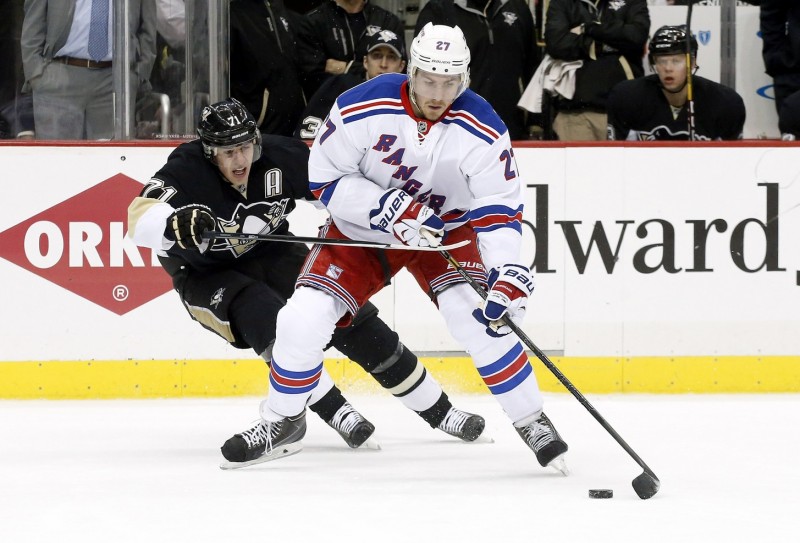
After the thrilling OT victory over the Pittsburgh Penguins in Game 1 of the Eastern Conference Semi-Finals on Friday, the New York Rangers came back in Game 2 with a dud.
While head coach Alain Vigneault wouldn’t admit it following the 3-0 loss, it was very easy to see that having four games in six nights finally caught up with the Rangers skaters as the fatigue factor set in.
The Blueshirts seemed to be one step behind throughout the entire game, and despite a stellar performance from goaltender Henrik Lundqvist, they just couldn’t find a way to get it done at the other end of the ice. A major factor in the lack of success stemming from the Rangers’ powerplay.
The result? A series knotted back up at 1-1 heading back to New York with less than 24 hours to correct their shortcomings and get that much needed mental and physical rest.
Power(less)play
When the game began, the Rangers found themselves in a position that nearly every other team would love to be in.
Just 10 minutes into the game, New York had three powerplay opportunities and a golden opportunity to take a commanding lead on the road en route to a 2-0 series lead.
It was the perfect scenario for almost any NHL team…except the Rangers.
For the last 8 games, the man advantage has been more of a disadvantage for the Rangers who since going 3 for 8 in their first couple of games this postseason, have now had a nightmarish 0 for 29 drought.
While the New York had the chance to take control of the game early, get on the board first, dictate the pace of the play, and quiet the rabid Pittsburgh crowd; instead it was the complete opposite for a team in desperate need for answers. Instead of jumping ahead, the powerplay struggled mightily once again, going 0 for 3 in the first period alone and giving the Penguins all the momentum from that point forward.
In the playoffs, one early penalty kill from the home team is enough to shift the play in their favor, while getting the crowd actively involved in that momentum swing. But three early kills and you have yourself a team on the brink of explosion, and the roof ready to fly off of the building.
That’s what the Rangers did to themselves tonight, and while the Penguins were busy as penalty killers, the Blueshirts spent that time quite simply as momentum killers.
An anemic powerplay is something that Rangers fans have gotten used to over the last few years, but this season it was supposed to be different.
With Brad Richards back to form, Rick Nash in his first full season on Broadway, Ryan McDonagh becoming a bonafide offensive force on the blue line, and the addition of Martin St. Louis down the stretch, this powerplay unit was supposed to finally be the one with the weapons to get it done.
For much of the year, Vigneault’s up-tempo and creative style allowed the Rangers players to have a more free-flowing and comfortable powerplay, and just as we had seen in Game 1 of the first round series vs. the Flyers, it made for a very fast and productive 5-on-4 advantage.
However since Game 3 of that same series, something suddenly changed. The players became indecisive, they started to hold the puck instead of keeping it moving, and the play became stagnant.
The Rangers spend parts of the two minutes inside of the zone with no movement, and trying to force diagonal passes instead of making the PK unit work. Then, they spend the other part of it trying to gain entry into the offensive zone with zero urgency and the utter lack of confidence that makes it easy for the opposing team to strip them of the puck, and send it back 200 feet the other way.
The personnel hasn’t changed, but for some reason that is hard to understand, the mindset has. Derek Stepan’s goal in Game 1 vs. Philly was the result of a beautiful tic-tac-toe play from St. Louis, up to Richards on the point, and finally down to Stepan back door for a wide open look at the net.
It was the kind of play that was purely instinctual, and was executed with precision and without hesitation. Also, it was the direct result of forcing the PK unit of the Flyers out of position after the Blueshirts shifted positions and kept moving their feet to find open ice.
Remember this?
Well it seems an awfully long time ago now doesn’t it? After coming into the zone, the Rangers moved the puck around too quickly for the Flyers defense to get set up in the shooting/passing lanes. This resulted in Derek Stepan emerging back door with so much room that even fans in the blue seats could have gotten to him sooner than an orange jersey.
Now, the Rangers look like statues out there, uncomfortable to the point where it looks like they would rather be down a man than up (which given the success of their penalty kill may almost be true).
There is no movement, no good shot attempts, and no coordination. Instead, you have a team that holds the puck like it was the last toy in the playpen – no one wants to give it up, even when they are being forced to share.
How the Rangers’ powerplay gets its groove back
For the remainder of the series, it is absolutely essential that the special teams come up huge. Right now, that means that the biggest key is getting the Rangers’ powerplay back on track.
How do they do this? Well, that probably what Vigneault is trying feverishly to figure out on the travel back to the Big Apple tonight.
The personnel is there, but the execution is just not. Potentially adding someone like Carl Hagelin, or bumping up Mats Zuccarello up to the first unit would give the Blueshirts the tweak that they need in order to get a different look on the PP.
They need more energy, more urgency, and more movement.
This is where the Rangers are really missing Chris Kreider, who during the regular season ranked third on the team with 6 powerplay goals, and provides a big, fast, and skilled body in front of the net. However, the reality is that Kreider (Broken Hand) is out indefinitely, and the Rangers shouldn’t expect to have him on the ice as the PP messiah anytime soon.

The big key here is movement: possibly have Richards and St. Louis criss-cross at the point while transferring the puck, and sending cutters through the crease in order to create some confusion and chaos in front of the net.
Also, the Rangers have stopped utilizing the quick give-and-go to the inside high slot and back out to the perimeter, which was very effective in getting the defense to collapse inside and get them moving. That is something that New York really needs to open back up in order to get expand their options and get them going.
They could try to work the overload to high umbrella, shifting the main focus from the side boards to the point, while shifting the shape of their PP in order to force the Penguins into a different formation and potentially open up some holes.
If I was Vigneault, I would make sure that the first thing I do to get this unit out of the incredible hole they are in, is to make sure that no matter what, there is always some sort of movement around the zone on the man advantage.
However, unless I am terribly confused, I am not Alain Vigneault, and in this particular circumstance I am very happy for that.
The Rangers head coach certainly has his work cut out for him over the next 17+ hours until both teams hit the ice again at Madison Square Garden for Game 3 with a crucial series lead at stake in front of The Garden Faithful.
While the Rangers do have the goaltending and depth to cause a lot of damage 5-on-5, they need to get their special teams in order if they want to place more pieces of that Stanley Cup puzzle on the wall of the locker room this spring.
It takes another 11 wins to get to the ultimate goal, and if the New York Rangers hope to get those wins, they are going to need an ultimate makeover on their powerplay.